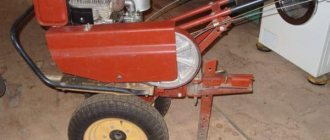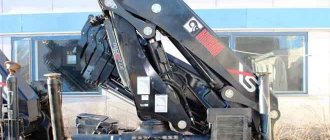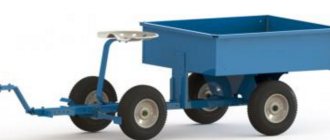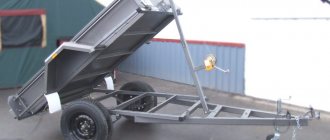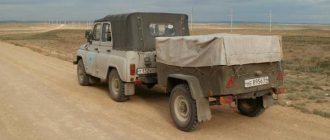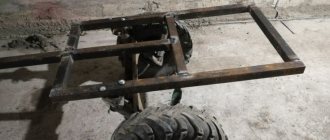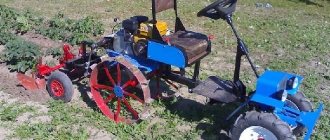Modern cars are mechanisms not only for transporting people, but also for optimizing their activities. Very often they are found complete with special body elements.
Kungs are a fairly common type of car that has certain technical and external features. More details about them can be found on the manufacturer's website.
What is "kung"
The abbreviation KUNG stands for Unified Body of Zero Dimensions. This type of closed body was originally developed for military vehicles. But he quickly found a use for himself in civilian life.
Kung is the “right thing” for Russian conditions. It not only protects the cargo from bad weather and theft, but also significantly improves the aerodynamic properties of the vehicle. A car equipped with the “correct” kung will easily pass through an arch/tunnel of the given dimensions. Installing a truck is a necessary upgrade that turns your pickup from a mini-truck into a comfortable, practical, stylish car.
Headrest with monitor: comfortable travel for rear passengers
- field kitchens;
- laboratories;
- residential trailers;
- workshops;
- medical stations;
- heating points;
- transport cabins;
- testing points;
- food storage, etc.
There are many options. You just need to take the body as a basis and equip it accordingly, which will allow you to get one or another version of the mobile system.
What can I say, when I was young, a military trailer-kung was used as a mobile station where people could take a fluorogram and donate blood for tests. In post-war times this was also necessary.
What types of kungs are there?
There are kungs, and there are covers for pickup trucks. They, in general, have the same functional tasks, and they differ mainly in form. Although there is a fundamental difference: a kung car allows car owners to transport larger, larger cargo.
The pickup truck cover fits flush with the side edge, completely enclosing the vehicle bed. It can be 1/2/3-sectional, or roller shutter. It costs, accordingly, less than a kung.
Kung is a different matter. It is larger in size and is level with the cabin of a mini-truck. It could be:
- one-piece structure without glass or hatches, which is a “canopy” with a rear door;
- “hardtop”, which has a built-in window and various bells and whistles such as a power window and lights;
- a practical and stylish “full box” that will make your universal utility vehicle sporty and even quite elegant. And it is almost indistinguishable from a cool SUV with a spacious interior.
If necessary, you can buy several types of kungs at once, for all occasions. They will differ both in functionality and appearance. An attractive and modern look is, of course, wonderful, but first of all, a pickup truck must be durable. This means the material from which it is made is important.
Kungs for Toyota Hilux
Kungs for
Caravans for Nissan NP300
Caravans for Nissan Navara
Kungs for Mitsubishi L200
Kungs for UAZ Patriot
Materials: special attention
What should a pickup truck be made of so that your luggage arrives at its destination safe and sound? Manufacturers of these irreplaceable accessories offer different options: hardtops made of fiberglass, ABS plastic, steel, aluminum. Each material has its own advantages, so the choice depends on your practical tasks.
Fiberglass “hard-top”
The kung hardtop made of plastic/fiberglass is lightweight and quite durable, and has a stylish appearance. The multilayer structure of fiberglass makes it impact-resistant and wear-resistant thanks to the technology of applying glass fibers. It is resistant to aggressive environments, has low thermal conductivity, and good electrical insulation characteristics. Therefore, such material is simply irreplaceable in car tuning.
If it was still not possible to avoid damage to the kung - for example, as a result of an accident - there is no need to worry. This is a completely repairable material that can be restored independently with epoxy resin and hands growing from the right place. But the fiberglass hard top is one of the most expensive.
Kungs made of ABS plastic
Lightweight, super-strong ABS plastic was clearly liked by leading kung manufacturers not for its “beautiful eyes,” although its appearance is quite presentable. Super durable, lightweight, hygienic because it consists of a homogeneous material. It holds paint well, but can do without it, as there are special coatings.
Steel kungs
For the manufacture of steel (metal) kungs for pickups, galvanized steel is used, therefore there is no corrosion or other damage. Even extreme Russian frosts are not scary for such kung trucks - no matter how much is overboard. They do not require delicate handling; they don’t even care about “shifters”.
Their strength is a separate issue. If you are fully loaded and still cannot fit everything you need, you can attach another hundred kilograms on top of the kung.
Kungs made of aluminum
This kung does not claim the title of “Mr. Universe”, but it is distinguished by increased durability. A reliable thing that has long been appreciated by farmers, builders, and hunting/fishing enthusiasts. Severe frosts and childish vibrations on native bumpy roads will not affect the trip in any way.
Those who have to work in difficult weather and road conditions, while covering long distances, have long appreciated the indisputable advantages of aluminum kungs. They are made on a welded frame and covered with thin but heavy-duty aluminum panels. The flat roof is reinforced with a special design, which allows you to secure an additional load weighing 100-150 kg on it.
Kung tents
Kung tent is an accessory from the “super-economy” series. It will, of course, protect your things from dirt, dust and prying eyes - but it will definitely not become an obstacle for dishonest individuals.
History[ | ]
The impetus for the production of closed van bodies was the Second World War, during which specialized vehicles of military units on an automobile chassis were already used. Life has shown the poor suitability of such bodies for actual use during combat operations, which required a close look at this problem after the end of the war.
The first full-fledged mobile workshops manufactured in the USSR in 1946-1948, called VAM (military automobile workshop), were mounted in captured German bodies on a Lend-Lease Studebaker US6 chassis.
The development of the first all-metal bodies was entrusted to the Dortransproekt Institute of the Ministry of Public Utilities of the RSFSR in the early 50s, according to the project of which the 38th pilot plant of the Main Automobile Directorate produced the prototypes of these bodies.
Based on the results of the tests, by the end of 1951, GLAVTU recommended the “SN” body for serial production to equip VAREM workshops, which at that time were produced by various enterprises and did not have a unified body. The remaining types of all-metal bodies were not accepted for supply to the Soviet army and were manufactured at the 38th Production Plant on a trial basis for the installation of various specialized equipment. The “SN” body was mass-produced, was subsequently modernized and received the designation “MRGT” after the type of mobile workshop, the equipment of which was housed in it.
Van body type "KUNG"
The appearance of KUNG-type bodies is associated with the difference in track width and, accordingly, loading dimensions of the railways of the USSR and European countries. After the end of the Great Patriotic War, many military units of the Soviet army were stationed in Eastern European countries. To ensure the transportability of such vehicles on railway platforms, the dimensions of the van bodies had to be tied to European dimensions. Russian railway gauge (1520 mm) is considered wide in the world,
and the European one (1435 mm) is
normal
, so the expression
“normal dimensions”
was included in the abbreviation.
Another interpretation is “zero size”
comes from the name of the Soviet loading gauge, corresponding to the European one - 02-T (02-VM).
Based on the first digit, it was called “zero”
(standard dimensions starting with the number “1” or a letter were used only within the USSR and did not pass into Europe).
GAZ-66 car with a KUNG van body.
KUNG van bodies were developed in the period 1953-1958. on the instructions of the Ministry of Defense of the USSR by the civilian SKB "Gazstroymashina", which is one of the divisions of the Central Design Bureau of the Ministry of Paper and Woodworking Industry of the USSR.
Structurally, all KUNG-type bodies were a wooden frame structure covered with steel sheets in the form of a booth with double-leaf horizontal glazing and an entrance door at the end of the body. KUNG booths were often equipped with internal electric lighting from the vehicle's on-board network and heating: initially simple wood-burning stoves were installed, then ventilation-type boiler heaters running on diesel fuel (OV-65, etc.) began to be installed in a container under the floor. Filter and ventilation systems on KUNG bodies have not become widespread due to the low tightness of the body structure.
Serial production of KUNG vans began in 1954 at the Shumerlinsky furniture plant in the city of Shumerlya, Chuvash Autonomous Soviet Socialist Republic.[1][2]
Background information: The Shumerlinsky woodworking plant was founded in 1931, with the beginning of the Second World War it was transferred to the People's Commissariat of the Aviation Industry under the subordination of the 11th Main Directorate of the NKAP, receiving the name “Plant No. 471”. The main products of the plant are G-11 gliders, Yak-6 and U-2 aircraft. Immediately after the war, the plant was repurposed to produce automobile vans for the Volga and Dvina RS (project No. 306c/203ps dated July 24, 1945). The plant's civilian products include the production of furniture.
The bodies were mounted: KUNG-1 - on the chassis of ZiS-150 and ZIL-164, KUNG-1M - on ZiS-151 and ZIL-157, KUNG-1MM - on ZIL-131, KUNG-2M - on GAZ-63 and GAZ -66-02, KUNG-P2M - on SMZ-710B and SMZ-810 trailers, KUNG-P6M on MAZ-5207V trailer, KUNG-P10 - on MAZ-5224V. In the 70s, several new types of frame-wooden vans were developed, in particular KUNG-1MD - on the ZIL-131 chassis, KUNG-66 on the GAZ-66 chassis, KUNG-1.P2M - on the SMZ-8326 trailer chassis (2- PN-2M), in the 80-90s KUNG-3307, KUNG-1.P2M4, KUNG-1.P; M4, KUNG-2.P6M-01 and many others. etc.
The latest designed model of a unified wooden body on an automobile chassis is considered to be the KUNG-3307 model, developed by VPKTI NPO Lesmash.
KUNG bodies were produced until the early 2000s. These were van trailers to house diesel generator stations. Today, the last manufacturer of trailer bodies KUNG-1.P6M-02 is considered to be the Kovylkinsky Electromechanical Plant.
Van body type "K"
Due to the fundamental shortcomings of KUNG type bodies, such as:
- low durability of the body structure due to the accumulation of moisture in the lower cavities and rotting of the frame
- lack of a developed power supply network and the ability to connect to an external power supply network
- insufficient tightness of the body in conditions of chemical and radioactive contamination
- lack of normal life support facilities (heating, ventilation, lighting)
- lack of unification of production
To develop new military vans, in July 1954 the design bureau of the 38th Experimental Plant GLAVTU of the USSR Ministry of Defense was created, where new unified frameless van bodies of the “K” series were developed. The first prototype of the body was made in 1959-1960 - it was type K66 on the chassis of the GAZ-66 car.
Subsequently, the K-66 body was adapted for installation on cars: K66U1 on the ZIL-131 chassis; K66U1D on ZIL-157 chassis; K66U2 on ZIL-130 chassis; K66U7 on trailer chassis 2-PN-2. Then the K375 body for the Ural-375 car went into development.
The Shumerlinsky plant, which already had experience in the production of KUNG-type vans, again became the enterprise for mastering production. The first K375A body was produced by the plant in July 1962. In accordance with the resolution of the Central Committee of the CPSU and the Council of Ministers of the USSR No. 125-395 of December 24, 1964, the Shumerlinsky plant was determined to be the lead manufacturer of K66 (all models) and K375 bodies. In May 1968, the plant received a new name - the Sumerlinsky Plant of Specialized Automobile Vans.
K series bodies:
- K66 on GAZ-66 chassis,
- K131 on ZIL-131 chassis,
- K500 on MAZ-500A chassis,
- K862 on the chassis of the Ural-862 semi-trailer,
- K4320 (K4320D) on the Ural-4320 (KAMAZ-4310) chassis,
- K5320 on KamAZ-5320 chassis,
- KP2 on trailer chassis 2-PN-2M,
- KP4 on trailer chassis 2-PN-4M,
- KP6 on trailer chassis 2-PN-6,
- KP6M on trailer chassis 2-PN-6M,
- KP10 on trailer chassis 2-PN-10,
- Gearbox15 on the MAZ-938B chassis.
Due to the complexity of the production of “K” series bodies and their high cost (the cost of the K66U1DV body produced by ShZSAF in 1969 was 3985 rubles, which was 1000 rubles higher than the cost of the base chassis - the ZIL-157KE car), frame-metal vans were developed “KM” series, unified with “K” vans in terms of basic technical specifications, equipment and accessories.
By the early 1970s, the army had more than 110 standard sizes of bodies for various purposes, installed on the chassis of both cars and trailers. These bodies were produced by almost 60 factories of different industries.
By destination: what we’re carrying, where we’re going
Why do car owners equip their cars with kungs? Each case is individual, but with a good kung, as they say, both the feast and the world. They can be used:
- for rest/overnight during expeditions;
- for commercial transportation, transportation of equipment and other goods;
- for hunting/fishing trips (in this case, manufacturers offer additional accessories);
- for long, multi-day trips (maximally strong body, storage compartments, overhead luggage rack).
A kung from a responsible manufacturer, regardless of its purpose, can be used for many years - until you get bored and want updates.
Warrior Qualities
- Tenderness is the ability to feel the enemy, anticipate his behavior in order to develop the optimal scheme of your actions.
- Directness is the consistent and unwavering implementation of the chosen scheme of actions necessary for victory, without regard to possible personal defeat.
- Impassivity - maintaining mental balance, gaining the ability to react not to a single action of the enemy, but to see him as a whole, assessing his combat capabilities as a whole.
- Gracefulness is the ability to move and act in a combat situation with the least expenditure of effort.
- Combinatorial thinking is the ability to choose optimal sets of movements and easily switch from one system to another, which is especially important when conducting a duel with several opponents.
Kung or cover: which is better
If you choose between a kung and a cover, then, again, it all depends on the functional tasks - and, of course, personal preferences. For example, fans of country style will probably prefer to drive around in a pickup truck, demonstrating to the whole world the unpretentious simplicity of the truck. So they will vote for the cap. City dwellers usually have different aesthetic preferences; a kung car is more suitable for them, which, as already mentioned, often gives a “farm” car a resemblance to a crossover.
From a practical point of view, a kung is better in the sense that it is much more spacious. In addition, it is attached to the body as tightly as possible, literally adjacent. This means that your cargo is completely insured against moisture, dust, and debris.
Where are they used?
As we have already noticed, many people associate the word kung only with the superstructure over the body of a pickup truck. In fact, this is a military development and the intended purpose of the kung is to precisely meet the needs of the army. Such designs are in demand because they are versatile and suitable for a wide range of needs.
Despite modern modernization to suit the needs of a civilized person, such kungs have retained their function. As planned, they should be unified bodies, the purpose of which was already determined by the interior of the module.
On the car accessories market you can purchase a kung of suitable sizes and adapt it according to your own wishes. The main thing is that the frame and chassis are in good condition. The rest is a matter of taste.
Foam set
Glue the prepared foam cubes into the spaces between the panels (Fig. 3). In practice, each “brick” has to be adjusted to its place individually. They are sawed with a sharp hacksaw on wood from sheets of 50x100x10 cm of ordinary construction foam. The gluing areas are sanded with P40 sandpaper inserted into a paint cracker (holder). The “bricks” are glued onto high-quality PVA glue. The glue is applied in a line from the tube spout to each surface to be glued. You will still have places where there are gaps between the bricks; in such places you need to glue small pieces of foam plastic, securing them with nails to the fixed “bricks”, like pins. After the glue has dried, the nails are removed.
The history of the appearance of Universal Bodies of Zero (Normal) Dimensions
Maxim Shelepenkov, photo by the author, Ivan Andreev, Timur Dokuchaev, Alexander Novikov, Yuri Petrov
I hear this question quite often. At first glance, it is not difficult to answer. Today, any insulated booth on a car or trailer is called KUNG. You can also add that this is an abbreviation for Universal Body of Zero (Normal) Dimensions . Everything is clear and understandable, but if you delve a little into the history of this issue, it turns out... that we often call the wrong bodies KUNGs!
Before you find out what a real KUNG is, you need to understand the definition of zero (normal) size, encrypted in its name. At the end of the 1940s, a need arose to bring the dimensions of PARM-type automobile bodies to one size in order to make them easily transportable, primarily on European railways.
TTX[ | ]
Information taken from the reference book “Technical means of logistics support”, ed. Moscow 2003. Edited by the Chief of Logistics of the Armed Forces of the Russian Federation - Deputy Minister of Defense of the Russian Federation, Army General V. I. Isakov.
(some body types are shown for comparison)
- van body K66N - unified sealed, made of reinforced foam panels: GAZ-66 base chassis
- load capacity 1480 kg
- body weight in running order 1020 kg
- body dimensions with car L-W-H, mm: 5950 x 2400 x 2975
- body volume m3: 10.2
- air transportation: An-12, Il-76
- van body KM131 - unified sealed frame-metal base chassis ZIL-131
- load capacity 2700 kg
- body weight in running order 1650 kg
- body dimensions with car L-W-H, mm: 7470 x 2450 x 3146
- body volume m3: 13.5
- air transportation: An-22, Il-76
- van body KM4310 - unified sealed frame-metal base chassis KamAZ-4310
- load capacity 5200 kg
- body weight in running order 1800 kg
- body dimensions with car L-W-H, mm: 7925 x 2540 x 3310
- body volume m3: 22.03
- air transportation: An-22, Il-76
- van body K862 - unified sealed, made of reinforced foam panels base chassis: truck tractor Ural-44201-862
- load capacity 6500 kg
- body weight in running order 3500 kg
- body dimensions with car L-W-H, mm: 17500 x 2550 x 3250
- body volume m3: 30.0
- air transportation: An-22, Il-76
Automotive MTO workshop on ZIL-131 chassis inside
Some special and logistics support vehicles mounted on the basis of standard van bodies:
- maintenance workshop for automobile or autotractor (tracked, armored) vehicles MTO-A (AT, ATG, AM, etc.) is one of the most common special vehicles in the Armed Forces of the USSR and the Russian Federation, which has been widely supplied to all branches of the military since the early 60s . The prototype of the MTO was a workshop of the VAREM-3 type, mounted on the chassis of a ZIS-151A truck. The MTO-A workshop was mounted on the ZIL-131 base chassis, the equipment was placed in a K131 or KM131 van body.
- repair and locksmith workshop MRS-AT based on ZIL-131 with K131 or KM131 van body
- mechanical repair workshop MRM-M based on ZIL-131 with K131 or KM131 van body
- ambulance vehicle AS-66 MPP, based on GAZ-66 with K66 body
- special vehicle AR-2U - a mobile X-ray unit in the back of the K131 car ZIL-131
- control center DP-RB - trailer 2-PN-2M with van KUNG-P2M
- military filter station VFS-10 on a ZIL-131 chassis with a K131 body
and many more etc.
Covering the model with newspaper
Move to this stage only when you decide that the surface of the model is what you want the finished product to be. Prepare a water solution of PVA glue and a lot of old (non-glossy) newspapers. Tear the newspapers into 10x10 cm squares for flat surfaces, 5x10 cm for curves and even smaller ones for sharp corners. Apply the glue solution to both sides of the newspaper and the place on the model where the newspaper will be glued. Smooth the newspaper onto the model with a brush. One layer of newspaper is enough, the main thing is to avoid gaps. Pieces of newspaper overlap each other, avoid folds. When pasting, make sure that the outer edge of the kung seat (which you made from laminate) is not stained with glue or covered with newspaper. While pasting it is better to cover it with masking tape, and after the newspaper has dried, remove and clean the laminate with sandpaper. Newspapers will dry on the surface of the kung in 2-4 days at normal room temperature. To speed up drying, you cannot use a directional emitter - you will ruin the model, only general heating of the air in the room. Draw an opening on the surface of the newspaper along the remaining indentations.
